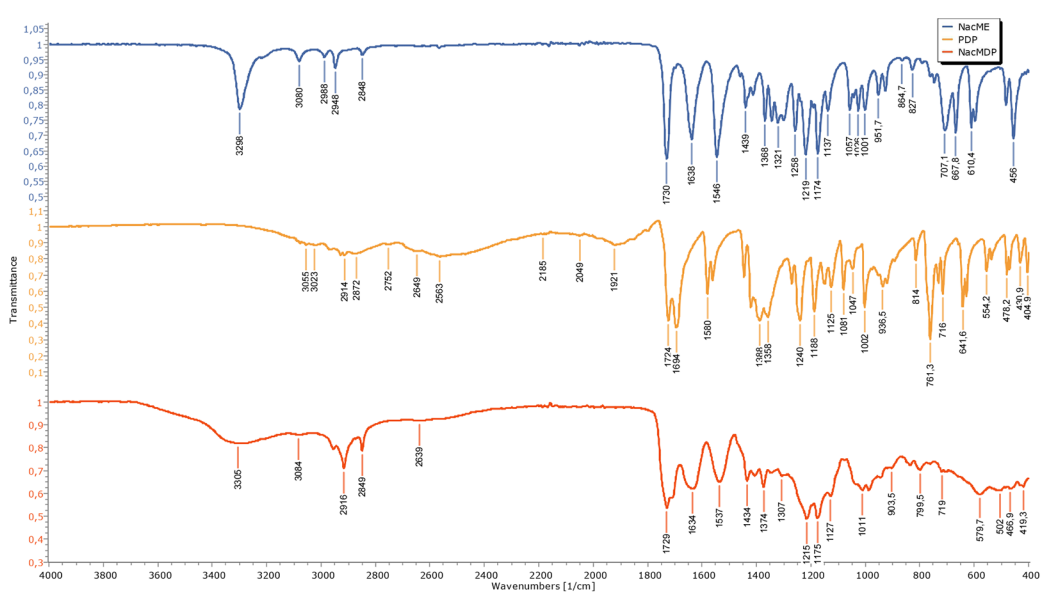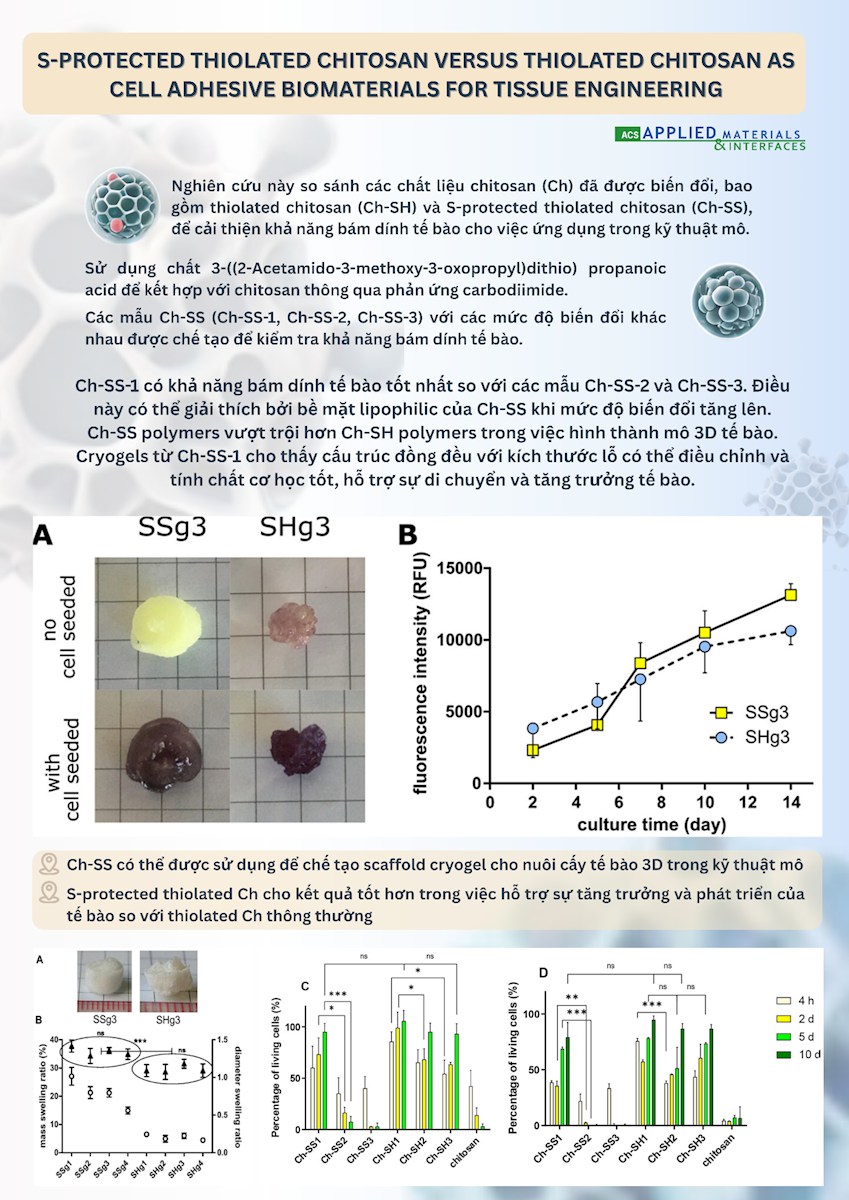Bao Le-Vinh, Christian Steinbring, Nguyet-Minh Nguyen Le, Barbara Matuszczak, and Andreas Bernkop-Schnürch*
Published in ACS Applied Materials & Interfaces, 2023
Một nghiên cứu gần đây được công bố trên Tạp chí Vật liệu và Ứng dụng ACS đã giới thiệu một phương pháp đột phá nhằm cải thiện vật liệu trong kỹ thuật tạo mô. Các nhà nghiên cứu đã phát triển chitosan thiolated bảo vệ S (Ch-SS), một dạng biến thể của chitosan giúp tăng cường khả năng bám dính tế bào—một đặc tính quan trọng đối với sự tái tạo mô. Chitosan và các dẫn xuất của nó từ lâu đã được sử dụng trong kỹ thuật tạo mô nhờ tính tương thích sinh học và các đặc tính cơ học của chúng. Tuy nhiên, khả năng hỗ trợ sự bám dính tế bào, yếu tố quan trọng đối với sự tái tạo mô, lại bị hạn chế. Nghiên cứu này chỉ ra rằng việc thêm nhóm disulfide vào chitosan giúp cải thiện đáng kể khả năng bám dính tế bào, biến nó thành một vật liệu hiệu quả hơn để tạo ra các giá đỡ trong kỹ thuật tạo mô.
Tổng Hợp và Thử Nghiệm Các Dẫn Xuất Chitosan
Các nhà nghiên cứu đã tổng hợp ba loại chitosan thiolated bảo vệ S với các mức độ biến đổi khác nhau và so sánh hiệu suất của chúng với chitosan thiolated. Nghiên cứu phát hiện rằng chitosan biến đổi (Ch-SS-1) có khả năng bám dính tế bào vượt trội, dẫn đến sự phát triển và sinh trưởng tế bào tốt hơn. Những phát hiện này cho thấy Ch-SS có thể được sử dụng để tạo ra các giá đỡ không chỉ tương thích sinh học mà còn hiệu quả hơn trong việc hỗ trợ sự bám dính tế bào—một yêu cầu thiết yếu trong kỹ thuật tạo mô. Thêm vào đó, nghiên cứu còn chỉ ra rằng các giá đỡ Ch-SS có thể được chế tạo thành cryogels—các giá đỡ 3D giúp cải thiện sự di chuyển và phát triển của tế bào.

Tác Động Đến Kỹ Thuật Tạo Mô và Y Học Tái Tạo
Tiến bộ này có thể mang lại những tác động lớn đối với kỹ thuật tạo mô và y học tái tạo. Khả năng tạo ra các giá đỡ có thể điều chỉnh hỗ trợ sự bám dính và phát triển tế bào là yếu tố quan trọng giúp cải thiện kết quả trong các liệu pháp tái tạo, đặc biệt là trong việc phục hồi mô mềm. Các nhà nghiên cứu hy vọng rằng những phát hiện này sẽ dẫn đến sự phát triển của các vật liệu sinh học hiệu quả và tiết kiệm chi phí hơn, có thể được sử dụng trong nhiều ứng dụng khác nhau của kỹ thuật tạo mô, từ chữa lành vết thương đến tái tạo cơ quan.
Phiên bản tiếng Anh
A recent study published in ACS Applied Materials & Interfaces has introduced an innovative approach to improving tissue engineering materials. Researchers have developed S-protected thiolated chitosan (Ch-SS), a modified version of chitosan that enhances cell adhesion—an essential property for tissue regeneration. Chitosan and its derivatives have long been used in tissue engineering for their biocompatibility and mechanical properties. However, their ability to support cell adhesion, a crucial factor for tissue regeneration, has been limited. This study shows that by adding disulfide groups to chitosan, its cell-adhesive properties are significantly enhanced, making it a more effective biomaterial for constructing scaffolds in tissue engineering.
Synthesis and Testing of Chitosan Derivatives
The researchers synthesized three different S-protected thiolated chitosans with varying degrees of modification and compared their performance to thiolated chitosan. The study found that the modified chitosan (Ch-SS-1) demonstrated superior cell adhesion properties, leading to better cell growth and proliferation. These findings suggest that Ch-SS can be used to create scaffolds that are not only biocompatible but also more effective in supporting cell attachment, a critical requirement for tissue engineering. Additionally, the study showed that Ch-SS scaffolds could be fabricated into cryogels—3D scaffolds that allow for better cell migration and proliferation.
Implications for Tissue Engineering and Regenerative Medicine
This advancement could have significant implications for tissue engineering and regenerative medicine. The ability to create tunable scaffolds that promote cell adhesion and proliferation is essential for improving outcomes in regenerative therapies, especially for soft tissue repair. The researchers hope that their findings will lead to the development of more efficient and cost-effective biomaterials that can be used in a variety of tissue engineering applications, from wound healing to organ regeneration.

Link: S-Protected Thiolated Chitosan versus Thiolated Chitosan as Cell Adhesive Biomaterials for Tissue Engineering | ACS Applied Materials & Interfaces

